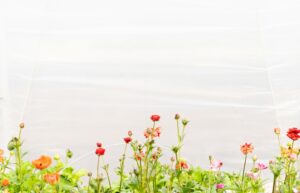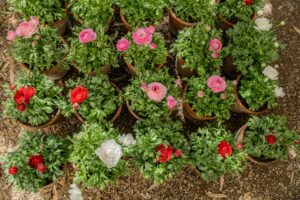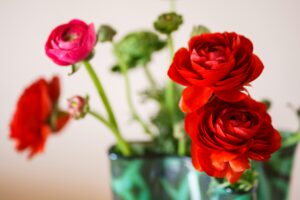Ranunculus flower which is commonly known as buttercups, is a genus of flowering plants in the family Ranunculaceae, which includes over 600 species. These herbaceous perennials are known for their vibrant and showy blooms, which resemble peonies or roses. Ranunculus flowers come in a wide range of colors, including white, yellow, orange, pink, red, and purple, making them popular choices for gardens, floral arrangements, and weddings.

The plant typically grows up to 18 to 24 inches (45 to 60 cm) in height, although some varieties can reach taller heights. Ranunculus feature deeply lobed, dark green foliage that adds to their ornamental appeal even when not in bloom.
The flowers of Ranunculus are characterized by multiple layers of delicate, papery petals, giving them a full and lush appearance. Each flower typically measures 2 to 4 inches (5 to 10 cm) in diameter, and they bloom in spring and early summer, although some varieties may flower later in the season. They typically bloom in spring and early summer, although some varieties may flower later in the season. Ranunculus plants grow from tuberous roots and feature deeply lobed, dark green foliage that adds to their ornamental appeal.

Ranunculus are versatile plants that can be grown in gardens, borders, containers, or as cut flowers. They prefer well-draining soil and full to partial sunlight, although they can tolerate some shade in warmer climates. Ranunculus plants require regular watering to keep the soil evenly moist but not waterlogged.
Despite their beauty, Ranunculus plants can be toxic if ingested by humans or animals, so care should be taken when planting them in areas frequented by pets or small children. With proper care, Ranunculus can reward gardeners with stunning displays of colorful blooms that add a touch of elegance to any landscape or floral arrangement.

Sunlight Requirement of Ranunculus Flower
Ranunculus flowers prefer full sun to partial shade. They thrive in locations where they receive at least 6 to 8 hours of sunlight each day. However, in hotter climates, providing some afternoon shade can help protect the flowers from the intense heat and prolong their blooming period. In regions with very hot summers, morning sun and afternoon shade may be ideal to prevent the flowers from wilting or becoming scorched. Overall, a balance of sunlight and shade throughout the day will promote healthy growth and abundant flowering in Ranunculus plants.

Temperature and Humidity Requirements of Ranunculus Flower
Ranunculus flowers prefer moderate temperatures for optimal growth and bloom. They thrive in temperatures ranging from 50 to 65 degrees Fahrenheit (10 to 18 degrees Celsius). While they can tolerate slightly warmer temperatures, it’s essential to ensure adequate air circulation and soil moisture to prevent overheating and wilting during hot weather. Ranunculus plants generally prefer moderate to high humidity levels. However, they can tolerate a wide range of humidity conditions as long as the soil moisture is consistent.

Soil Requirement
Ranunculus flowers thrive in well-draining soil with a slightly acidic to neutral pH level. A loamy soil texture is ideal, providing a balance of moisture retention and drainage. The soil should be rich in organic matter, such as compost, to promote healthy root growth and flowering.
Before planting ranunculus bulbs, it’s essential to prepare the soil by loosening it to a depth of about 6 to 8 inches (15 to 20 centimeters) and incorporating organic matter to improve soil structure and fertility. This preparation ensures that the soil retains adequate moisture without becoming waterlogged, which can lead to the rotting of the bulbs.

Propagation of Ranunculus Flower
Propagation and sowing of ranunculus corms are relatively straightforward. Here’s a step-by-step guide:
Choose healthy ranunculus corms from a reputable supplier or garden center. Look for corms that are firm, plump, and free from signs of decay or damage.
Ranunculus plants prefer well-draining soil and full sunlight. Prepare the planting site by loosening the soil to a depth of about 6 to 8 inches (15 to 20 centimeters) and incorporating organic matter, such as compost, to improve soil fertility and drainage.
Plant the ranunculus corms in the prepared soil with the “claws” or pointed ends facing downward and the rounded side facing upward. Space the corms about 4 to 6 inches (10 to 15 centimeters) apart and plant them at a depth of approximately 2 to 3 inches (5 to 7.5 centimeters).
After planting, water the corms thoroughly to settle the soil and ensure good contact between the corms and the soil. Keep the soil consistently moist but not waterlogged during the growing season, especially during periods of dry weather.
As the ranunculus plants grow, provide regular waterings, and monitor them for signs of pests or diseases. Applying a balanced fertilizer periodically can help support healthy growth and flowering.

By following these steps, you can successfully propagate and sow ranunculus corms, allowing you to enjoy their beautiful blooms in your garden or as cut flowers.
Water Requirements of Ranunculus Plant
Ranunculus plants have moderate water requirements, preferring consistently moist but well-draining soil. After planting ranunculus corms, water them thoroughly to settle the soil and ensure good contact between the corms and the soil. This initial watering helps to initiate root growth and establishment. Water deeply, allowing the moisture to penetrate the soil to the root zone. Aim to water the plants whenever the top inch (2.5 centimeters) of soil feels dry to the touch.

Fertilizer Requirement
Apply fertilizer to ranunculus plants when they are actively growing, typically in early spring as new growth emerges and continues throughout the growing season. Avoid fertilizing during dormancy or after the blooming period has ended. Use a balanced, water-soluble fertilizer formulated for flowering plants or a fertilizer specifically designed for bulbs and tubers. Look for a fertilizer with an N-P-K ratio (nitrogen-phosphorus-potassium) of around 10-10-10 or similar, which provides balanced nutrition for healthy foliage and blooms.

Deadheading Ranunculus Flower
Check the ranunculus plant regularly for faded or wilted flowers. Deadheading is most effective when done promptly after the flowers have faded. Pinch off the spent flower heads with your fingers or use sharp scissors or pruning shears to snip them off. Cut just above the first set of healthy leaves or where the flower stem joins the main stem. In some cases, entire flower clusters may be spent and need removal. In such instances, cut the entire stem back to where it meets the main stem or down to a lateral bud.

Problems while growing ranunculus flower
While ranunculus flowers are generally easy to grow, they can sometimes face challenges. Here are some common problems encountered when growing ranunculus flowers and their potential solutions:
Fungal Diseases: Ranunculus plants may be susceptible to fungal diseases such as powdery mildew, botrytis blight, and crown rot, especially in humid conditions or if overwatered. Provide good air circulation around plants, avoid overhead watering, and ensure proper spacing between plants to reduce humidity. Apply fungicides preventatively or as directed if disease symptoms appear.
Pest Infestations: Common pests that may affect ranunculus plants include aphids, slugs, snails, and spider mites. Monitor plants regularly for signs of pest infestations and take appropriate measures to control them. This may include handpicking pests, using insecticidal soap or neem oil, or applying organic pest controls.
Poor Flowering: Ranunculus plants may fail to produce abundant flowers if they are not receiving adequate sunlight, nutrients, or water. Ensure plants are grown in a location with full sun or partial shade, provide consistent moisture without waterlogging, and fertilize plants regularly with a balanced fertilizer formulated for flowering plants.
Bulb Rot: Improper planting depth, overwatering, or poorly drained soil can lead to bulb rot in ranunculus plants. Plant ranunculus bulbs at the correct depth (2-3 inches deep) in well-draining soil. Avoid overwatering and ensure soil dries out between waterings to prevent bulb rot.
Deer and Rabbit Damage: Ranunculus plants may be susceptible to damage from deer and rabbits, which may eat the foliage or flowers. Protect plants from browsing animals by using physical barriers such as fences or netting, or applying repellents around the garden perimeter.
By addressing these common problems and providing proper care, you can help ensure healthy growth and abundant flowering of your ranunculus plants. Regular monitoring, timely intervention, and proactive maintenance practices are key to overcoming challenges and enjoying beautiful blooms.

Ornamental Uses of Ranunculus Flower
Ranunculus flowers are prized for their vibrant colors, lush foliage, and delicate blooms, making them popular choices for various ornamental purposes. Here are some common ornamental uses of ranunculus flowers:
Garden Borders and Beds: Ranunculus flowers add a burst of color and texture to garden borders, beds, and mixed flower plantings. Their compact growth habit and attractive foliage make them versatile for landscape design.
Container Gardens: Ranunculus plants are well-suited for container gardening, where their colorful blooms can brighten up patios, balconies, and outdoor living spaces. They can be grown in pots, window boxes, or hanging baskets.

Cut Flower Arrangements: Ranunculus flowers are highly prized for floral arrangements due to their long stems, ruffled petals, and vibrant colors. They make stunning additions to bouquets, centerpieces, and floral displays, adding a touch of elegance and charm.

Wedding Flowers: Ranunculus blooms are popular choices for bridal bouquets, boutonnieres, and corsages, thanks to their romantic appearance and wide range of colors. They symbolize charm, beauty, and radiant allure, making them perfect for weddings and special occasions.
Indoor Decor: Ranunculus flowers can be enjoyed indoors as cut flowers or potted plants. Their long-lasting blooms and striking appearance brighten up any room, adding a touch of natural beauty to tabletops, mantels, and windowsills.

Dried Flower Arrangements: After the blooms fade, ranunculus flowers can be dried and preserved for use in dried flower arrangements and crafts. Their delicate petals retain their shape and color well when dried, making them ideal for wreaths, potpourri, and floral crafts.
Pollinator Gardens: While primarily grown for their ornamental value, ranunculus flowers also attract pollinators such as bees and butterflies to the garden, contributing to biodiversity and ecosystem health.

Overall, the ornamental uses of ranunculus flowers are diverse and versatile, making them beloved additions to gardens, floral arrangements, and decorative displays. Whether grown outdoors or enjoyed indoors, ranunculus blooms never fail to captivate with their beauty and charm.


